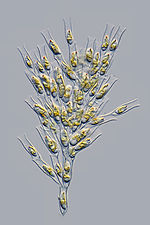Prymnesium parvum is a species of haptophyte (also collectively called Prymnesiophyta). The species is of concern because of its ability to produce the...
5 KB (674 words) - 16:34, 17 August 2024
Prymnesium is a genus of haptophytes, including the species Prymnesium parvum. The genus is a unicellular motile alga. It is ellipsoidal in shape one flagellum...
8 KB (601 words) - 13:27, 2 March 2024
of the prymnesins, a class of hemolytic phycotoxins made by the alga Prymnesium parvum. It is known to be toxic to fish, causing mass fish deaths around...
6 KB (461 words) - 14:51, 11 August 2024
freshwater. Golden algae is also commonly used to refer to a single species, Prymnesium parvum, which causes fish kills. The Chrysophyceae should not be confused...
16 KB (1,596 words) - 10:06, 11 October 2024
classified either as the Haptophyta, Haptophytina or Prymnesiophyta (named for Prymnesium), are a clade of algae. The names Haptophyceae or Prymnesiophyceae are...
16 KB (1,307 words) - 02:06, 23 October 2024
Prymnesium, a constitutive mixotroph that participates in toxic algal blooms....
99 KB (10,341 words) - 09:13, 10 November 2024
Prymnesin-2 is an organic compound that is secreted by the haptophyte Prymnesium parvum. It belongs to the prymnesin family and has potent hemolytic and...
12 KB (1,147 words) - 17:42, 9 October 2024
prymnesins, a class of ladder-frame polyether phycotoxins made by the alga Prymnesium parvum. It is known to be toxic to fish. It is a so called "B-type" prymnesin...
6 KB (311 words) - 08:42, 16 October 2024
there are Prymnesiophyceae species lacking coccoliths (e.g. in genus Prymnesium), so not every member of Prymnesiophyceae is a coccolithophore. Coccolithophores...
90 KB (9,375 words) - 10:01, 30 August 2024
the die-off. According to them, it was caused by golden algae (likely Prymnesium parvum, which prefer warm salty alkaline waters). Researchers at the Leibniz...
31 KB (2,601 words) - 20:13, 1 June 2024







